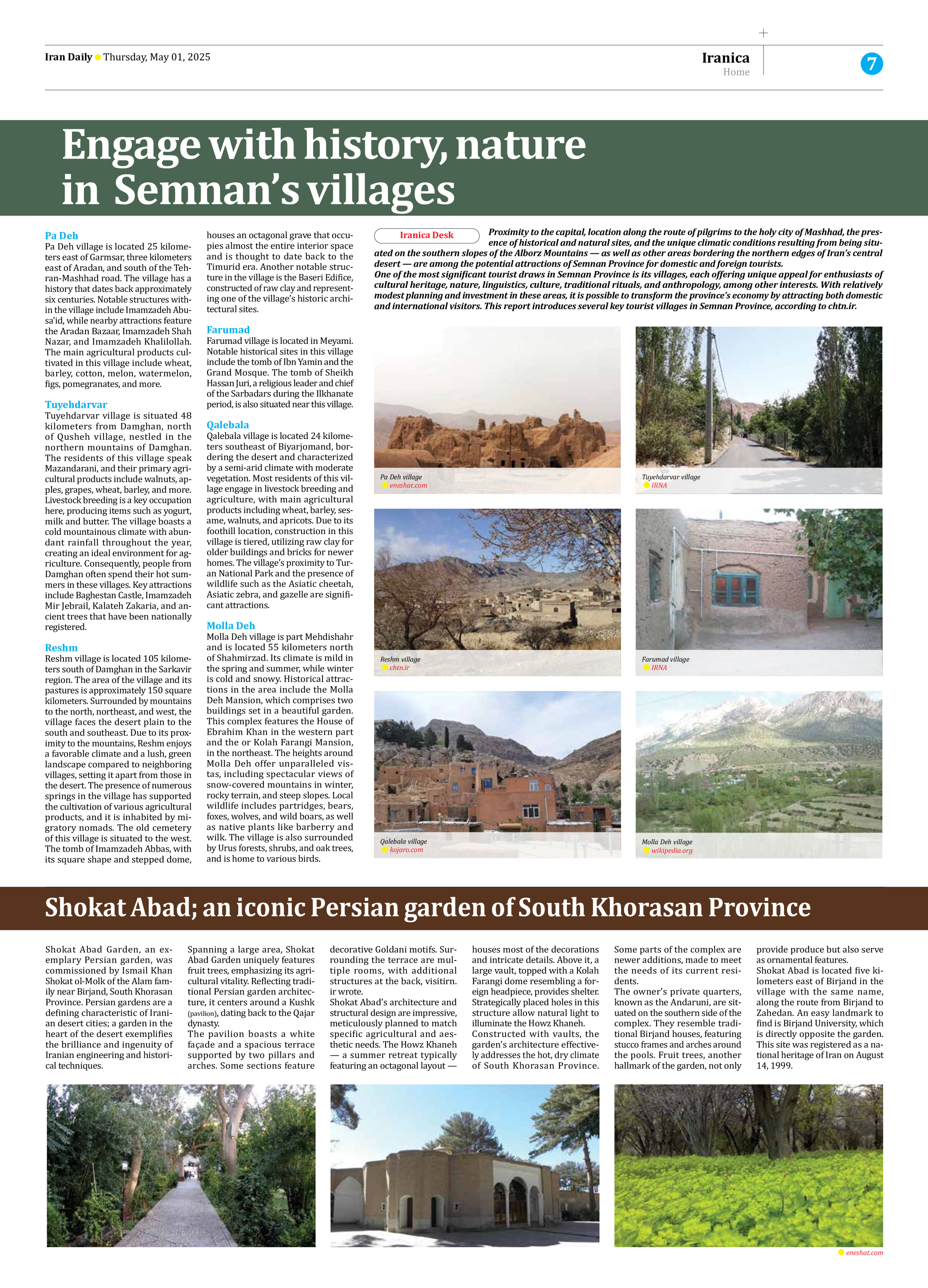
Engage with history, nature in Semnan’s villages
Proximity to the capital, location along the route of pilgrims to the holy city of Mashhad, the presence of historical and natural sites, and the unique climatic conditions resulting from being situated on the southern slopes of the Alborz Mountains — as well as other areas bordering the northern edges of Iran’s central desert — are among the potential attractions of Semnan Province for domestic and foreign tourists. One of the most significant tourist draws in Semnan Province is its villages, each offering unique appeal for enthusiasts of cultural heritage, nature, linguistics, culture, traditional rituals, and anthropology, among other interests. With relatively modest planning and investment in these areas, it is possible to transform the province’s economy by attracting both domestic and international visitors. This report introduces several key tourist villages in Semnan Province, according to chtn.ir.
Pa Deh
Pa Deh village is located 25 kilometers east of Garmsar, three kilometers east of Aradan, and south of the Tehran-Mashhad road. The village has a history that dates back approximately six centuries. Notable structures within the village include Imamzadeh Abusa’id, while nearby attractions feature the Aradan Bazaar, Imamzadeh Shah Nazar, and Imamzadeh Khalilollah. The main agricultural products cultivated in this village include wheat, barley, cotton, melon, watermelon, figs, pomegranates, and more.
Tuyehdarvar
Tuyehdarvar village is situated 48 kilometers from Damghan, north of Qusheh village, nestled in the northern mountains of Damghan. The residents of this village speak Mazandarani, and their primary agricultural products include walnuts, apples, grapes, wheat, barley, and more. Livestock breeding is a key occupation here, producing items such as yogurt, milk and butter. The village boasts a cold mountainous climate with abundant rainfall throughout the year, creating an ideal environment for agriculture. Consequently, people from Damghan often spend their hot summers in these villages. Key attractions include Baghestan Castle, Imamzadeh Mir Jebrail, Kalateh Zakaria, and ancient trees that have been nationally registered.
Reshm
Reshm village is located 105 kilometers south of Damghan in the Sarkavir region. The area of the village and its pastures is approximately 150 square kilometers. Surrounded by mountains to the north, northeast, and west, the village faces the desert plain to the south and southeast. Due to its proximity to the mountains, Reshm enjoys a favorable climate and a lush, green landscape compared to neighboring villages, setting it apart from those in the desert. The presence of numerous springs in the village has supported the cultivation of various agricultural products, and it is inhabited by migratory nomads. The old cemetery of this village is situated to the west. The tomb of Imamzadeh Abbas, with its square shape and stepped dome, houses an octagonal grave that occupies almost the entire interior space and is thought to date back to the Timurid era. Another notable structure in the village is the Baseri Edifice, constructed of raw clay and representing one of the village’s historic architectural sites.
Farumad
Farumad village is located in Meyami. Notable historical sites in this village include the tomb of Ibn Yamin and the Grand Mosque. The tomb of Sheikh Hassan Juri, a religious leader and chief of the Sarbadars during the Ilkhanate period, is also situated near this village.
Qalebala
Qalebala village is located 24 kilometers southeast of Biyarjomand, bordering the desert and characterized by a semi-arid climate with moderate vegetation. Most residents of this village engage in livestock breeding and agriculture, with main agricultural products including wheat, barley, sesame, walnuts, and apricots. Due to its foothill location, construction in this village is tiered, utilizing raw clay for older buildings and bricks for newer homes. The village’s proximity to Turan National Park and the presence of wildlife such as the Asiatic cheetah, Asiatic zebra, and gazelle are significant attractions.
Molla Deh
Molla Deh village is part Mehdishahr and is located 55 kilometers north of Shahmirzad. Its climate is mild in the spring and summer, while winter is cold and snowy. Historical attractions in the area include the Molla Deh Mansion, which comprises two buildings set in a beautiful garden. This complex features the House of Ebrahim Khan in the western part and the or Kolah Farangi Mansion, in the northeast. The heights around Molla Deh offer unparalleled vistas, including spectacular views of snow-covered mountains in winter, rocky terrain, and steep slopes. Local wildlife includes partridges, bears, foxes, wolves, and wild boars, as well as native plants like barberry and wilk. The village is also surrounded by Urus forests, shrubs, and oak trees, and is home to various birds.







